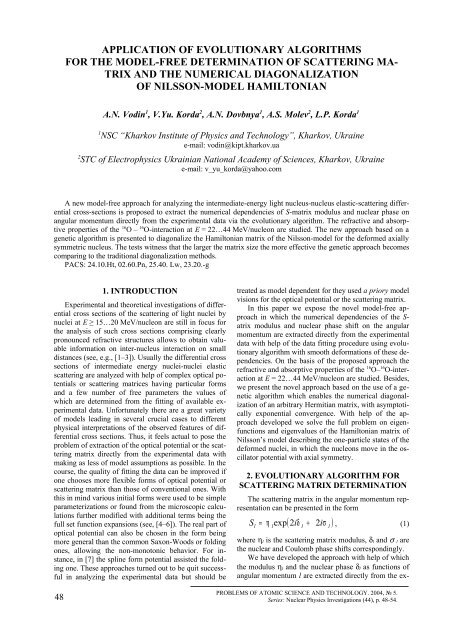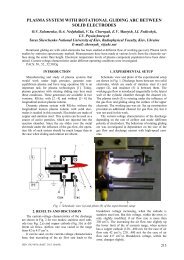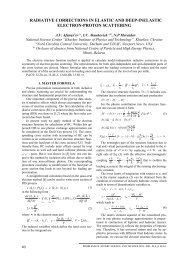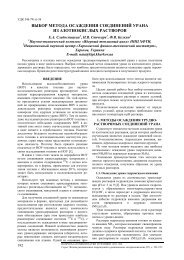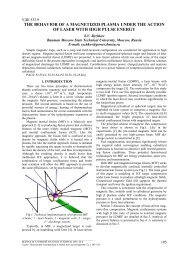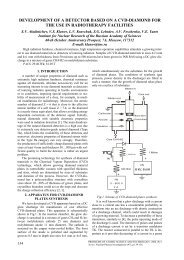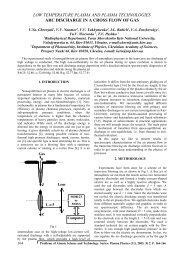APPLICATION OF EVOLUTIONARY ALGORITHMS FOR THE ...
APPLICATION OF EVOLUTIONARY ALGORITHMS FOR THE ...
APPLICATION OF EVOLUTIONARY ALGORITHMS FOR THE ...
Create successful ePaper yourself
Turn your PDF publications into a flip-book with our unique Google optimized e-Paper software.
<strong>APPLICATION</strong> <strong>OF</strong> <strong>EVOLUTIONARY</strong> <strong>ALGORITHMS</strong><br />
<strong>FOR</strong> <strong>THE</strong> MODEL-FREE DETERMINATION <strong>OF</strong> SCATTERING MA-<br />
TRIX AND <strong>THE</strong> NUMERICAL DIAGONALIZATION<br />
<strong>OF</strong> NILSSON-MODEL HAMILTONIAN<br />
А.N. Vodin 1 , V.Yu. Korda 2 , А.N. Dovbnya 1 , A.S. Molev 2 , L.P. Korda 1<br />
1<br />
NSC “Kharkov Institute of Physics and Technology”, Kharkov, Ukraine<br />
e-mail: vodin@kipt.kharkov.ua<br />
2<br />
STC of Electrophysics Ukrainian National Academy of Sciences, Kharkov, Ukraine<br />
e-mail: v_yu_korda@yahoo.com<br />
A new model-free approach for analyzing the intermediate-energy light nucleus-nucleus elastic-scattering differential<br />
cross-sections is proposed to extract the numerical dependencies of S-matrix modulus and nuclear phase on<br />
angular momentum directly from the experimental data via the evolutionary algorithm. The refractive and absorptive<br />
properties of the 16 О – 16 О-interaction at Е = 22…44 МeV/nucleon are studied. The new approach based on a<br />
genetic algorithm is presented to diagonalize the Hamiltonian matrix of the Nilsson-model for the deformed axially<br />
symmetric nucleus. The tests witness that the larger the matrix size the more effective the genetic approach becomes<br />
comparing to the traditional diagonalization methods.<br />
PACS: 24.10.Ht, 02.60.Pn, 25.40. Lw, 23.20.-g<br />
1. INTRODUCTION<br />
Experimental and theoretical investigations of differential<br />
cross sections of the scattering of light nuclei by<br />
nuclei at Е ≥ 15…20 МeV/nucleon are still in focus for<br />
the analysis of such cross sections comprising clearly<br />
pronounced refractive structures allows to obtain valuable<br />
information on inter-nucleus interaction on small<br />
distances (see, e.g., [1–3]). Usually the differential cross<br />
sections of intermediate energy nuclei-nuclei elastic<br />
scattering are analyzed with help of complex optical potentials<br />
or scattering matrices having particular forms<br />
and a few number of free parameters the values of<br />
which are determined from the fitting of available experimental<br />
data. Unfortunately there are a great variety<br />
of models leading in several crucial cases to different<br />
physical interpretations of the observed features of differential<br />
cross sections. Thus, it feels actual to pose the<br />
problem of extraction of the optical potential or the scattering<br />
matrix directly from the experimental data with<br />
making as less of model assumptions as possible. In the<br />
course, the quality of fitting the data can be improved if<br />
one chooses more flexible forms of optical potential or<br />
scattering matrix than those of conventional ones. With<br />
this in mind various initial forms were used to be simple<br />
parameterizations or found from the microscopic calculations<br />
further modified with additional terms being the<br />
full set function expansions (see, [4–6]). The real part of<br />
optical potential can also be chosen in the form being<br />
more general than the common Saxon-Woods or folding<br />
ones, allowing the non-monotonic behavior. For instance,<br />
in [7] the spline form potential assisted the folding<br />
one. These approaches turned out to be quit successful<br />
in analyzing the experimental data but should be<br />
treated as model dependent for they used a priory model<br />
visions for the optical potential or the scattering matrix.<br />
In this paper we expose the novel model-free approach<br />
in which the numerical dependencies of the S-<br />
atrix modulus and nuclear phase shift on the angular<br />
momentum are extracted directly from the experimental<br />
data with help of the data fitting procedure using evolutionary<br />
algorithm with smooth deformations of these dependencies.<br />
On the basis of the proposed approach the<br />
refractive and absorptive properties of the 16 О– 16 О-interaction<br />
at Е = 22…44 МeV/nucleon are studied. Besides,<br />
we present the novel approach based on the use of a genetic<br />
algorithm which enables the numerical diagonalization<br />
of an arbitrary Hermitian matrix, with asymptotically<br />
exponential convergence. With help of the approach<br />
developed we solve the full problem on eigenfunctions<br />
and eigenvalues of the Hamiltonian matrix of<br />
Nilsson’s model describing the one-particle states of the<br />
deformed nuclei, in which the nucleons move in the oscillator<br />
potential with axial symmetry.<br />
2. <strong>EVOLUTIONARY</strong> ALGORITHM <strong>FOR</strong><br />
SCATTERING MATRIX DETERMINATION<br />
The scattering matrix in the angular momentum representation<br />
can be presented in the form<br />
S<br />
l<br />
l<br />
( 2iδ<br />
+ iσ<br />
)<br />
= η exp 2 , (1)<br />
l<br />
where η l is the scattering matrix modulus, δ l and σ l are<br />
the nuclear and Coulomb phase shifts correspondingly.<br />
We have developed the approach with help of which<br />
the modulus η l and the nuclear phase δ l as functions of<br />
angular momentum l are extracted directly from the ex-<br />
l<br />
48<br />
PROBLEMS <strong>OF</strong> ATOMIC SCIENCE AND TECHNOLOGY. 2004, № 5.<br />
Series: Nuclear Physics Investigations (44), p. 48-54.
perimental data (the Coulomb phase σ l is assumed to<br />
poses the quasi-classic form of the point charge scattering<br />
by the uniformly charged sphere with radius R C [8],<br />
which is legitimated by the high enough energy of scattering)<br />
without assuming any additional model assumptions.<br />
In our approach the values of η l and δ l for each l<br />
are treated as independent fitting parameters. Thus the<br />
parameter space of the variation problem has high dimension<br />
and one has to choose an adequate optimization<br />
method.<br />
Evolutionary algorithm is the one of choice the application<br />
of which turned out to be quite efficient in<br />
solving such different and hard problems as the integration<br />
of differential equations [9], Thomson’s problem on<br />
the minimum energy configuration of N point charges<br />
on a unit sphere [10], the optimization of thermodynamic<br />
analysis of phase transitions in ferroelectrics [11], the<br />
construction of the light exotic nuclei bound state wave<br />
functions [12, 13], the optimization of parameters of the<br />
energy dependent optical potential for the elastic scattering<br />
of heavy ions by nuclei [14], the analysis of spectra<br />
of quantum systems [15], the optimization of kinematics<br />
of nuclear physics experiments [16], etc.<br />
The only condition the modulus η l and the phase δ l<br />
must obey is the requirement for them to have smooth<br />
form. Alongside with that one should note that at<br />
Е ≥ 15…20 МeV/nucleon the number of fitting parameters<br />
usually exceeds the number of experimental points.<br />
To avoid overfitting we have devised the special mutation<br />
operator with dispersion. The developed algorithm<br />
consists of the following steps:<br />
1. The initial population of n individuals is created,<br />
each of which including the pair of real-valued vectors<br />
(η l, δ l) of dimension l max with l = 0,…, l max -1. The initial<br />
dependencies η l and δ l are chosen in the analytical form<br />
η<br />
l<br />
2<br />
⎛ L ⎞<br />
= exp<br />
a a a l r ⎜ 2 ⎟<br />
⎝ ∆<br />
r ⎠<br />
( − µ g(<br />
L,<br />
L , ∆ )),<br />
2δ<br />
= µ exp⎜<br />
− ⎟ ,<br />
⎡ ⎛ L − L ⎞ ⎤<br />
a<br />
g ( L,<br />
L , ) ⎢1<br />
exp<br />
⎜<br />
⎟<br />
a<br />
∆<br />
a<br />
= +<br />
⎥ ,<br />
(2)<br />
⎢⎣<br />
⎝ ∆<br />
a ⎠ ⎥⎦<br />
49<br />
− 1<br />
where L = l + 1/2, the parameter µ a determines the magnitude<br />
of absorption, the parameters L a and ∆ a (µ r and ∆<br />
r) characterize the size of the region of absorption (nuclear<br />
refraction) in the angular momentum space. These<br />
shapes of the modulus η l and the nuclear phase δ l meet<br />
the condition of smooth alteration with the increase of l<br />
(see [17]) and correctly account for the character of absorption<br />
and refraction in the process of scattering of<br />
light nuclei by nuclei at intermediate energies. The values<br />
of the parameters µ a, µ r, L a, ∆ a and ∆ r from Eq. (2)<br />
are the random ones uniformly distributed in wide<br />
range. Thus this choice of the initial representation of η l<br />
and δ l does not influence the final result obtained with<br />
the algorithm at hand.<br />
2. The elastic scattering differential cross section is<br />
calculated and the value of χ 2 is found for each of the<br />
individual from the population. The procedure uses the<br />
amplitude of elastic scattering in the form of the Legendre<br />
polynomials expansion. The differential cross section<br />
is determined by the squared modulus of this amplitude.<br />
3. According to the χ 2 magnitude, two parent individuals<br />
are selected randomly from the population (the<br />
lower the magnitude of χ 2 the higher the probability to<br />
be selected) to create two offsprings using the transformation<br />
⎡<br />
⎤<br />
⎢<br />
⎥<br />
'<br />
0,25 (0, 1)<br />
ln(<br />
) ln( ) ⎢ aN<br />
η 1<br />
⎥<br />
l<br />
= η<br />
l<br />
+<br />
,<br />
⎢<br />
2<br />
⎛ l − l ⎥<br />
0 ⎞<br />
⎢ 1 + ⎜ ⎟ ⎥<br />
⎢⎣<br />
⎝ d ⎠ ⎥⎦<br />
⎡<br />
⎤<br />
⎢<br />
⎥<br />
' ⎢ 0,25aN(0,<br />
1)<br />
δ 1<br />
⎥<br />
l<br />
= δ<br />
l<br />
+<br />
,<br />
⎢<br />
2 ⎥<br />
(3)<br />
⎢<br />
⎛ l − l0<br />
⎞<br />
1 + ⎜ ⎟ ⎥<br />
⎢⎣<br />
⎝ d ⎠ ⎥⎦<br />
where a is the mutation amplitude, N(0, 1) is the normally<br />
distributed one-dimensional random variable with<br />
zero mean and one standard deviation, l 0 is the random<br />
point of mutation, d is the dispersion characterizing the<br />
size of the mutation region.<br />
The values of l 0 and N(0, 1) are generated ones for<br />
each string of η и δ. The control parameters a and d alter<br />
in intervals [a min, a max] and [d min, d max] chosen by the<br />
user. These parameters are automatically tuned by the<br />
computational program in the specified intervals. The<br />
mutation operator (3) is nonlocal and if the values of a<br />
'<br />
and d are set properly the transformed functions η<br />
l<br />
and<br />
'<br />
δ<br />
l will be smooth. In order to provide monotonicity of<br />
the extracted functions η l and δ l we first find the minimum<br />
value<br />
χ at which these functions still poses the<br />
2<br />
mon<br />
property. Then while χ 2 2<br />
decreases below χ<br />
mon we apply<br />
the additional condition due to which the maximal relative<br />
alteration of the functions η l and δ l can not exceed<br />
some small value (say 10 -4 , as in our case).<br />
4. For each of two offsprings the elastic scattering<br />
differential cross section is calculated and χ 2 magnitude<br />
is determined.<br />
5. According to the χ 2 magnitude, two individuals<br />
are selected randomly from the population (the higher<br />
the magnitude of χ 2 the higher the probability to be selected)<br />
to be substituted by the offsprings.<br />
6. Go to step 3.<br />
For the details of the selection procedure see exposition<br />
in [18].<br />
3. RESULTS AND DISCUSSION<br />
We have carried out the model-free study of the refractive<br />
and absorptive properties of 16 О – 16 О-interaction<br />
at Е = 22…44 МeV/nucleon. The choice of the<br />
16<br />
О + 16 О system is conditioned by the fact that there<br />
exit valuable discrepancies between the S-matrix module<br />
and deflection functions, characterizing absorptive<br />
and refractive properties of interaction, respectively, obtained<br />
with use of different models (phenomenological
optical model, folding model and S-matrix model with<br />
Regge poles) (see [19, 20]). Therefore, it is important to<br />
get new reliable information on the scattering matrix in<br />
the cases under study.<br />
σ/σ R<br />
а<br />
σ/σ R<br />
b<br />
10 -2 3<br />
10 -2 1<br />
η<br />
10 0 3<br />
а<br />
η<br />
b<br />
10 -1<br />
10 -2<br />
10 -3<br />
2<br />
1<br />
0 20 40 60 80 100 L<br />
Θ , deg<br />
0<br />
-20<br />
-40<br />
-60<br />
2<br />
1<br />
3<br />
0 20 40 60 80 100 L<br />
c<br />
10 -1 3<br />
1<br />
10 -3<br />
2<br />
d<br />
0 20 40 60 80 100 L<br />
Θ , deg<br />
0<br />
3<br />
-20<br />
-40<br />
-60<br />
1<br />
2<br />
0 20 40 60 80 100 L<br />
Fig. 1. The modulus of scattering matrix (а, b) and<br />
the deflection function (c, d) for elastic 16 О – 16 О-scattering:<br />
b, d and curves 1 (а, c) are for Е = 350 МeV<br />
while curves 2 (а, c) are for Е = 480 МeV and<br />
curves 3 (а, c) are for Е = 704 МeV<br />
The results of analysis of differential cross sections<br />
of elastic 16 О – 16 О-scattering at Е = 350, 480 and 704<br />
МeV carried out with help of the proposed approach are<br />
exposed in Figs. 1 - 3. The values of control parameters<br />
of the evolutionary algorithm are presented in Table<br />
alongside the χ 2 magnitudes and the total reaction cross<br />
sections σ r. Besides the boundary values for a and d, the<br />
Table contains their initial (a i and d i) and final (a f and d f)<br />
values. The calculations utilized n = 100 and<br />
R С = 0,95·2·16 1/3 [23]. The values of parameters of the<br />
representations (2) altered in wide intervals: L a = 30,0…<br />
55,0; ∆ a = 4,0…14,0; ∆ r = 20,0…50,0; µ a = 4,0…10,0,<br />
µ r = 5,0… 50,0 which provided for the various enough<br />
initial conditions. The amount of χ 2 calculations were<br />
1,4⋅10 6 , ⋅3,8⋅10 6 and 2,0⋅10 6 iterations for Е = 350, 480<br />
and 704 МeV respectively.<br />
The calculated differential cross sections were<br />
symmetrized for the scattering of the identical nuclei.<br />
Figs. 2 and 3 show that the application of the developed<br />
approach allows to obtain good agreement between the<br />
calculated and measured cross sections. As in [19] the<br />
fitting of differential cross sections was held with the<br />
standard experimental error of 10%. The scattering<br />
matrix (1) for the cases shown on Figs. 1, а, c is<br />
characterized by smooth dependence on L since the<br />
extracted smooth monotonic functions of L. The<br />
boundary from<br />
10 -4<br />
1<br />
2<br />
10 -5<br />
0 20 40 60 80 0 20 40 60 80<br />
o<br />
θ<br />
Fig. 2. The ratio of the differential cross section of<br />
elastic 16 О – 16 О-scattering at Е = 350 МeV and its<br />
components to the Rutherford one: curves 1 – 3 (а) are<br />
the cross section and its refractive and absorptive components<br />
calculated with the S-matrix to which the<br />
curves 1 in Fig. 1, а, c correspond; curves 1 – 3 (b) are<br />
the cross sections calculated with the S-matrix to which<br />
the curves 1 – 3 in Fig. 1, b, d correspond. The points<br />
are the experimental data taken from [21, 22]<br />
σ/σ R<br />
10 -2 1<br />
10 -4<br />
2<br />
а<br />
3<br />
σ/σ R<br />
1<br />
10 -3 2<br />
0 20 40 60 0 20 40<br />
o<br />
θ<br />
Fig. 3. The same as in Fig 2, а but for<br />
Е = 480 МeV (а) and Е = 704 МeV (b). а, b show the<br />
results of calculations with the S-matrix to which the<br />
curves 2 and 3 in Fig. 1, а, c correspond. The points are<br />
the experimental data taken from [19]<br />
the data module η(L) and nuclear phases δ(L) are<br />
smooth monotonic functions of L. The boundary momenta<br />
of strong absorption L sa defined from the correlation<br />
η 2 (L sa) = 0,5 with help of the dependencies η(L)<br />
shown on Fig. 1, а acquire the values: L sa = 58,1; 66,3<br />
and 76,9 at Е = 350, 480 и 704 МeV respectively. The<br />
deflection functions Θ(L) = 2(δ L – δ L–1) + 2dσ(L)/dL in<br />
the cases under study have the forms typical of the cases<br />
of nuclear rainbow (see Fig. 1, c). The angles of nuclear<br />
rainbow corresponding to the minima of Θ(L) are equal<br />
to θ R = 64; 41 and 26° at Е = 350, 480 and 704 МeV respectively.<br />
Note that the values of θ R found at Е = 350<br />
b<br />
3<br />
3<br />
2<br />
50
and 480 МeV are in good agreement with the ones obtained<br />
on the basis of the folding model with the density<br />
dependent nucleon-nucleon interaction [19] and the<br />
nine-parameter S-matrix model [24].<br />
The control parameters of the evolutionary algorithm<br />
used in the calculations of the differential cross<br />
sections of elastic 16 О – 16 О-scattering at different energies<br />
Parameter<br />
Value<br />
350 MeV 480 MeV 704 MeV<br />
l max 120 135 160<br />
a min 10 -2 10 -3 10 -5<br />
a max 0,9 0,9 0,9<br />
a i 0,9 0,9 0,9<br />
a f 1,3·10 -2 1,2·10 -2 1,6·10 -4<br />
d min 5,5 7,0 9,5<br />
d max 100,0 100,0 100,0<br />
d i 80,0 90,0 100,0<br />
d f 6,5 7,0 11,5<br />
χ 2 2,5 1,9 1,1<br />
σ r, mb 1693 1581 1483<br />
In order to clarify the degree to which the nuclear refraction<br />
and the strong absorption are responsible for the<br />
formation of different features of the elastic 16 О – 16 О-<br />
scattering in different regions of scattering angles θ<br />
Figs. 2, а and 3 display the refractive and diffractive<br />
components of the cross sections studied calculated due<br />
to the method proposed in [25]. Figs. show that at<br />
θ ≥ 20…25° the refractive components (curves 2) almost<br />
totally replicate the respective differential cross<br />
sections, particularly they describe fine details of the<br />
rainbow “tail” in the cases of the scattering at Е = 480<br />
and 704 МeV. The diffractive components (curves 3)<br />
dominate in the regions of Fraunhofer oscillations at<br />
small angles θ.<br />
When the values of dispersion d min decrease to 2,0…<br />
2,5 and the procedure of additional control of monotonicity<br />
of the extracted dependencies η(L) and δ(L) is<br />
switched off the behavior of the modulus η(L) in the region<br />
of small momenta becomes non-monotonic. In this<br />
region there arise isolated structures (“humps”) like the<br />
ones shown on Figs. 1, b (curves 1, 2) for the scattering<br />
at Е = 350 МeV while the deflection function has the<br />
similar form as in Fig. 1, c. Note the values of those parameters<br />
of calculations for the curves 1, 2 in Fig. 2, b<br />
which differ from the ones mentioned in the Table:<br />
d min = d f = 2,0, a min = 0,0, a f = 6,4·10 -11 , σ r = 1667 mb<br />
(curve 1), d min = 2,0, d f = 2,6, a min = 10 -3 , a f = 6,5·10 -3 , σ<br />
r = 1678 mb (curve 2).<br />
Fig. 2 shows that the use of the different forms of<br />
the scattering matrix to which the curves 1 and 2 in<br />
Fig. 1, b, c and the curves 1 in Fig. 1, а, c correspond<br />
gives equivalent quality of fit of the data although in the<br />
region of large enough scattering angles (θ > 70°) some<br />
discrepancy between the differential cross sections obtained<br />
is however observed. Therefore, the detailed<br />
structure of η(L) in the region of small momenta containing<br />
small “humps” the character size of which λ<br />
h ≈ 7/k ≈ 0,9 fm (k is the wave number) is compared<br />
with the wave length of the relative motion of colliding<br />
nuclei λ = 2π/k ≈ 0,8 fm should not be assigned any<br />
physical meaning and its existence is not necessary for<br />
the correct explanation of the available experimental data.<br />
Thus the monotonic function (see Fig. 1, а) smoothly<br />
altering from small values to unity with the increase of<br />
L may be used as a modulus η(L) of scattering matrix<br />
for the 16 О + 16 О system at the energy under study.<br />
Note that when the program of calculations automatically<br />
selected the conditions for S(L) corresponding to<br />
the case of week nuclear refraction we found the differential<br />
cross section (curve 3 in Fig. 2, b) for which χ<br />
2<br />
= 0,6 (d f = 9,3, a min = 10 -3 , a f = 9,2·10 -3 , σ r = 1590 mb).<br />
In the context the question remains on how deep physical<br />
meaning might have the oscillation structures in the<br />
modulus of the scattering matrix and the deflection<br />
function (see curves 3 in Fig. 1, b, c). Obviously this result<br />
should be considered as a physical nonsense and<br />
only the smooth behavior of η(L) and δ(L) without any<br />
additional structures characterizes correctly the effects<br />
of absorption and refraction in the 16 О – 16 О-scattering<br />
at the energies under study.<br />
These conclusions contradict the results of the work<br />
[20] in which the differential cross section of elastic<br />
16<br />
О – 16 О-scattering was analyzed on the basis of the<br />
ten-parameter S-matrix model allowing for the pole factor<br />
and the strong influence of Regge poles and zeros of<br />
S-matrix lying in the vicinity of the real axes in the<br />
complex L plane on the refractive behavior of the studied<br />
cross sections at Е ≤ 480 МeV was found. The account<br />
for the poles and zeros of S-matrix strongly violates<br />
the smoothness of S(L). Due to that the character<br />
of refraction and absorption at L ≤ L sa in this approach<br />
substantially differs from that of the discussed above<br />
(see curves 1, 2 in Fig. 1, а, c).<br />
4. GENETIC ALGORITHM BASED NUMER-<br />
ICAL DIAGONALIZATION <strong>OF</strong> HERMITIAN<br />
MATRIX. <strong>APPLICATION</strong> TO NILSSON<br />
MODEL<br />
The variability of shapes of atomic nuclei is an important<br />
property of nuclear matter. It is well established<br />
that the majority of nuclei are deformed both in ground<br />
and excited states. The study of the influence of the nuclear<br />
deformations in different states on various observables<br />
is permanently in the focus [26].<br />
One of the most simple but physically rich approaches<br />
to the systematics of the energy level bands of<br />
the deformed nuclei is Nilsson’s [27] model in which<br />
51
the nucleons are placed in the self-consistent field described<br />
by the oscillator potential with axial symmetry.<br />
The key point in the calculations of the one-particle<br />
states in this model is the diagonalization of the Hamiltonian<br />
matrix in the basis of the one-particle wave functions<br />
of the spherical oscillator potential.<br />
The full solution of the problem of searching eigenfunctions<br />
and eigenvalues of the Hermitian matrix can<br />
be found using the most developed and effective Jacobi’s<br />
method – the so-called plane rotations one. The<br />
method consists in the successive transformation of the<br />
initial matrix H = H 0 into the more simple form by multiplying<br />
it with the matrix of plane rotation U. As a result<br />
there arises a series H 0, H 1, H 2,… in which<br />
H k = U kH k-1U k<br />
-1<br />
and U k is selected to make the matrix H k<br />
not contain the non-diagonal element of the matrix H k-1,<br />
having the maximal absolute value. If H k = ║h ij<br />
(k)<br />
║, │h pq<br />
(k-<br />
1)<br />
│ = max (k-1) (k)<br />
i ≠ j<br />
│h ij │ U k = ║u ij ║, then for the real matrix<br />
H we have<br />
( k ) ( k )<br />
u<br />
pp<br />
= u = cos ϕ ( k ) ( k )<br />
, u = − u = sin ϕ ,<br />
qq<br />
pq<br />
( k − 1)<br />
2hpq<br />
tg 2ϕ<br />
= ( k − 1) ( k − 1)<br />
, ϕ ≤ π / 4 . (4)<br />
h − h<br />
pp<br />
qq<br />
The sequence of the matrices H k asymptotically squarely<br />
converges to the diagonal matrix. Besides, all the diagonal<br />
elements of the final matrix H k turn out to be the<br />
approximate eigenvalues of H while the rows of the matrix<br />
U k = U 1U 2…U k become the approximate eigenvectors.<br />
Within this method the most time-consuming procedure<br />
is the search for the non-diagonal element of the<br />
diagonalized matrix, having maximal absolute value.<br />
Thus in practice various methods are employed to accelerate<br />
or optimize this process.<br />
From the other hand, the full solution of the problem<br />
of searching eigenfunctions and eigenvalues of the Hermitian<br />
matrix is provided with help of the unitary transformation<br />
describing n - dimensional rotation (n is the<br />
dimension of the diagonalized matrix) which, using the<br />
generalized Euler angles [28], can be presented in the<br />
form:<br />
( n− 1 ) ( )<br />
g = g ...g 1 , g<br />
g<br />
j<br />
k<br />
( θ )<br />
j<br />
⎪⎧<br />
x<br />
j<br />
' = x<br />
⇒ ⎨<br />
⎪⎩<br />
x<br />
j+<br />
1'<br />
= −<br />
qp<br />
( k ) k k<br />
= g1 ( θ<br />
1<br />
)...<br />
gk<br />
( θ<br />
k<br />
) ,<br />
k<br />
k<br />
j<br />
⋅ cos( θ<br />
j<br />
) + x<br />
j+<br />
1<br />
⋅ sin( θ<br />
j<br />
)<br />
k<br />
k<br />
x ⋅ sin( θ ) + x ⋅ cos( θ )<br />
j<br />
j<br />
j+<br />
1<br />
1 ≤ k ≤ n − 1, 1 ≤ j ≤ k , (5)<br />
1 2<br />
1 2 1 2<br />
0 ≤ θ<br />
1<br />
, θ<br />
1<br />
,... < 2π<br />
, 0 ≤ θ<br />
2<br />
, θ<br />
2,...,<br />
θ<br />
3,<br />
θ<br />
3,<br />
... < π . (6)<br />
j<br />
,<br />
To this end the problem can be considered as the one of<br />
finding the optimal set of n(n-1)/2 values of Euler angles<br />
minimizing the sum of absolute values of all nondiagonal<br />
elements of the matrix under diagonalization in<br />
the rotated basis. To solve the problem we have applied<br />
the genetic algorithm which varies the optimized parameters<br />
independently and in parallel and has the exponential<br />
convergence rate.<br />
The scheme of application of a genetic algorithm to<br />
the problem under study is as follows. Each of the optimized<br />
Euler angles is presented via the binary encoding.<br />
The population consists of the fixed number of sets of<br />
these angles. Initially all the angles are set randomly in<br />
the specified intervals (6). Then for each set of angles<br />
the unitary transformation matrix (5) is calculated and<br />
applied to the diagonalized matrix and the sum of absolute<br />
values of all non-diagonal elements of the transformed<br />
matrix is determined. Further two parent sets of<br />
angles are selected from the population according to the<br />
prescription – the less the sum of absolute values of<br />
non-diagonal elements the greater the probability to be<br />
selected. The selected sets of angles are replicated to<br />
produce offsprings. During the replication, some bits of<br />
the binary codes representing the angles are flipped with<br />
some probability (mutation). After that, the exchange of<br />
the complementary portions of bits between the parent<br />
sets of angles takes place with some probability<br />
(crossover). For each offspring the sum of the absolute<br />
values of all non-diagonal elements of the transformed<br />
primary matrix is calculated. If the value of offspring’s<br />
sum becomes less the largest value of individual’s sum<br />
in the population, the latter is substituted by the former.<br />
The same way the next pair of parents is selected and<br />
the process proceeds until the required quality of diagonalization<br />
is achieved. Then the diagonal elements of<br />
the matrix H’ = gHg -1 are the approximate eigenvalues<br />
of H and the rows of the matrix g are the approximate<br />
eigenvectors.<br />
Using the diagonalization method presented above,<br />
we have independently replicated the one-particle energy<br />
states scheme found by Nilsson via Jacobi’s method.<br />
The comparative analysis of the developed approach<br />
and the conventional ones (e.g., Jacobi’s) shows that the<br />
higher the dimension of the matrix under diagonalization<br />
the higher the efficacy of the genetic approach.<br />
5. CONCLUSIONS<br />
The proposed model-free approach allows to extract<br />
the numerical dependencies of the modulus of S-matrix<br />
and the nuclear phase on the angular momentum directly<br />
from the measured differential cross sections of elastic<br />
scattering. This approach is free from the a priori visions<br />
of the shape of the nuclear part of scattering matrix.<br />
The results of analyses of the differential cross sections<br />
of elastic 16 О – 16 О-scattering at 22…44 МeV/nucleon<br />
featured by the pronounces refractive picture of<br />
rainbow scattering witness that the quantitative description<br />
of the available experimental data is achieved with<br />
the use of the scattering matrix determined by the modulus<br />
and the nuclear phase being smooth monotonic<br />
functions of angular momentum while the deflection<br />
function has the form typical of the case of nuclear rainbow.<br />
It should be noted that we have studied the case of<br />
the elastic scattering of identical nuclei limited in angular<br />
distributions by θ < 90° so that one can miss some<br />
important details of rainbow structures. From this point<br />
52
of view it seems reasonable to extract numerical dependencies<br />
of the S-matrix modulus and nuclear phase shift<br />
on angular momentum from the differential cross sections<br />
for elastic 16 О – 12 C-scattering at E( 16 О) = 230…<br />
281 MeV with help of the fitting procedure based on the<br />
evolutionary algorithm and find out whether these characteristics<br />
are smooth monotonic functions in the angular<br />
momentum space.<br />
Nilsson’s model allows successful description of the<br />
ground state properties of light nuclei with 4
teraction // Nucl. Phys. A. 1988, v. 487, № 3,<br />
p. 477-492.<br />
24. A.S. Molev, V.Yu. Korda. Analysis of refractive<br />
effects in 16 O – 16 O-scattering on the basis<br />
of S-matrix approach with the use of a genetic algorithm.<br />
Proc of the 52th Meeting on nuclear spectroscopy<br />
and nuclear structure (NUCLEUS-2002),<br />
2002, p. 164 (in Russian).<br />
25. A.S. Molev. Extraction of refractive and<br />
diffractive contributions to cross sections for inelastic<br />
scattering of light ions with E ≥ 20 MeV/nucleon<br />
by nuclei // Izvestiya RАN, Physics Series.<br />
1995, v 59, № 1, p. 96-102 (in Russian).<br />
26. H. Röpke, P.M. Endt. Renaissance of the<br />
Nilsson-model approach to light nuclei: The case<br />
of the A = 26 system // Nucl. Phys. A. 1998, v. 632,<br />
№ 2, p. 173-204.<br />
27. S.G. Nilsson. Bound states of individual nucleons<br />
in highly deformed nuclei // Kgl. Danske<br />
Videnskab. Selkab. Mat.-fys. Medd. 1955, v. 29,<br />
№ 16, p. 1-68.<br />
28. N.Ya. Vilenkin. Special functions and the<br />
theory of representations of groups. Мoscow:<br />
“Nauka”, 1991, 576 p. (in Russian).<br />
29. V.Yu. Gonchar, Е.V. Inopin, S.P. Tsytko.<br />
Light nuclei and generalized model. Preprint KIPT,<br />
1959, Д-001, 37 p. (in Russian).<br />
30. Е.V. Inopin, Е.G. Kopanets, L.P. Korda,<br />
V.Ya. Kostin, А.А. Koval’. Electromagnetic transitions<br />
in nuclei between states with different deformations<br />
// Problems of Atomic Science and Technology.<br />
Series: Nuclear Physics Investigations.<br />
1975, № 3(15), p. 31-33 (in Russian).<br />
31. Е.G. Kopanets, Е.V. Inopin, L.P. Korda.<br />
Analog-antianalog М1-transition at different deformations<br />
of initial and final states // Izvestiya АN<br />
SSSR, Physics Series, 1975, v. 10, № 39, p. 2032-<br />
2033 (in Russian).<br />
32. Е.G. Kopanets, Е.V. Inopin, L.P. Korda,<br />
V.Ya. Kostin, А.А. Koval’. М1 and Е2 transitions<br />
between nuclear states with different deformations<br />
// Izvestiya АN SSSR, Physics Series. 1976, v. 4,<br />
№ 40, p. 780-783 (in Russian).<br />
ПРИМЕНЕНИЕ ЭВОЛЮЦИОННЫХ АЛГОРИТМОВ ДЛЯ БЕЗМОДЕЛЬНОГО ОПРЕДЕЛЕНИЯ<br />
МАТРИЦЫ РАССЕЯНИЯ И ЧИСЛЕННОЙ ДИАГОНАЛИЗАЦИИ ГАМИЛЬТОНИАНА<br />
В МОДЕЛИ НИЛЬСCОНА<br />
А.Н. Водин, В.Ю. Корда, A.Н. Довбня, А.С. Молев, Л.П. Корда<br />
Предложен новый безмодельный подход для анализа дифференциальных сечений упругого рассеяния<br />
легких ядер промежуточных энергий ядрами, позволяющий извлекать численные зависимости модуля и<br />
ядерной фазы матрицы рассеяния от орбитального момента непосредственно из экспериментальных данных<br />
с помощью эволюционного алгоритма. Изучены преломляющие и поглощающие свойства 16 О – 16 О-взаимодействия<br />
при Е = 22…44 МэВ/нуклон. Представлен новый метод диагонализации матрицы гамильтониана в<br />
модели Нильссона деформированного ядра с аксиальной симметрией, использующий генетический алгоритм.<br />
Тестирование показало, что чем больше размер диагонализуемой матрицы, тем эффективнее оказывается<br />
генетический подход по сравнению с традиционными методами диагонализации.<br />
ЗАСТОСУВАННЯ ЕВОЛЮЦІЙНИХ АЛГОРИТМІВ ДЛЯ БЕЗМОДЕЛЬНОГО ВИЗНАЧЕННЯ<br />
МАТРИЦІ РОЗСІЯННЯ І ЧИСЕЛЬНОЇ ДІАГОНАЛІЗАЦІЇ МАТРИЦІ ГАМІЛЬТОНІАНУ<br />
В МОДЕЛІ НІЛЬСОНА<br />
О.М. Водін, В.Ю. Корда, A.М. Довбня, О.С. Молєв, Л.П. Корда<br />
Запропоновано новий безмодельний підхід для аналізу диференціальних перерізів пружного розсіяння<br />
легких ядер проміжних енергій ядрами, що дає змогу визначати числові залежності модуля і ядерної фази<br />
матриці розсіяння від орбітального моменту безпосередньо з експериментальних даних за допомогою<br />
еволюційного алгоритму. Досліджені заломлюючі та поглинаючі властивості 16 О – 16 О-взаємодії при<br />
Е = 22…44 МеВ/нуклон. Представлено новий метод діагоналізації матриці гамільтоніану в моделі Нільсона<br />
деформованого ядра з аксіальною симетрією, що застосовує генетичний алгоритм. Тестування довело, що<br />
чим більше розмір діагоналізуємої матриці, тим ефективнішим виявляється генетичний підхід порівняно з<br />
традиційними методами діагоналізації.<br />
54


